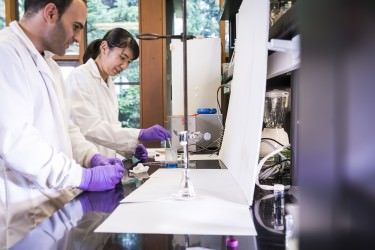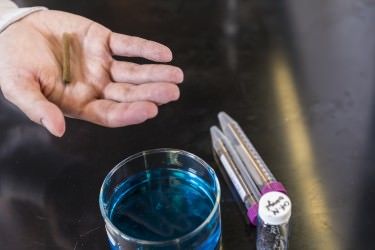Removing Colors from Water with New, Sponge-Like Material
Published on by Water Network Research, Official research team of The Water Network in Technology
A team led by the University of Washington has created an environmentally-friendly way to remove color from dyes in water in a matter of seconds.
 The technique was described in a paper published online in June in the journal Applied Catalysis B: Environmental.
The technique was described in a paper published online in June in the journal Applied Catalysis B: Environmental.
“A small amount of dye can pollute a large volume of water, so we needed to find a way to very quickly and efficiently remove the color,” said senior author Anthony Dichiara, an assistant professor of bioresource science and engineering in the UW School of Environmental and Forest Sciences. “We were pretty impressed with what we were able to achieve.”

Anthony Dichiara, left, and Jin Gu prepare an experiment to remove color from water using a sustainably made, reusable sponge material. Mark Stone/University of Washington
The research team developed a method that removes color from water using a sponge-like material they created from wood pulp and small bits of metal. Cellulose, the main structure in plant cell walls and the most abundant natural material on Earth, provides the backbone of the material, which is decorated with tiny pieces of palladium. This metal serves as a catalyst to help remove color quickly.

The UW’s sponge-like material, left, is made from wood pulp and small bits of metal that can remove color from dyes in water within seconds .Mark Stone/University of Washington
Instead of removing dye from water, the research team sought to change the color of the dyes to something that falls outside of what we can see in the visible spectrum. A chemical reaction can, for example, disrupt the color red and make it appear clear, or colorless. In the case of dye waste products that artificially color the water in lakes and prevent photosynthesis, changing the dye from red to clear should allow plants to grow normally again.
The chemical reduction of dyes using molecules called “reducing agents” can alter the dye structure and change its color from red or blue to clear. However, the reaction is not very efficient and can take weeks to occur. The UW’s material contains a catalyst that works with the reducing agent to speed this process up to almost instantaneous.
The researchers combined cellulose molecules with palladium metal, heated the solution and mixed it in a blender. Then they purified and freeze-dried the material so it became a porous, reusable substance. The resulting sponge is more than 99 percent air — its large pores allow water to flow in and out, while the metal catalyst particles within the material work to remove any color present.
Just like a real sponge, the material can be squeezed of its water and reused multiple times without losing the ability to remove color from water. The researchers say it is difficult to make such a lightweight material that is flawless after many rounds of squeezing and filtering, especially when the sponge must maintain its Swiss cheese-like structure fused with color-reducing particles.
The researchers tested their sponge in the lab using blue and red dyes commonly found in the textile industry. They poured the colored water — already mixed with the existing molecule that helps reduce color — over the sponge. As the liquid passed through the material, the resulting water was clear. In another test, they swirled the sponge material inside a jar containing blue-dyed water, and after about 10 seconds the color disappeared.

Researchers hold a small piece of the sponge-like material in water containing blue dye. After about 10 seconds, the water in the beaker turns clear. Click on each image in the sequence to view it larger. Photos by Mark Stone/University of Washington
Outside of lab tests, the researchers say that many small sponge-like materials could be released into a lake polluted with dye, along with the molecule to help reduce the color. Similar to swirling a tea bag round a mug, the sponges could be dragged around the lake until all of the color disappears.
“Just a little amount of dye can change the color of a lake dramatically,” Dichiara said. “This method could work well when you have low concentrations of dye in water that you need to take care of really quickly.”
First author is Jin Gu, a visiting scholar at the UW and associate professor at South China Agricultural University, and other co-authors are Chuanshuang Hu and Weiwei Zhang of South China Agricultural University.
Funding for this work is from the Guangdong Provincial Department of Science and Technology, the U.S. Department of Agriculture’s National Institute of Food and Agriculture, and the Bureau of Guangdong Forestry.
Read more about removing dyes from water with a sponge-like material at the University of Washington
Attached link
http://www.youtube.com/embed/a70IvqljlS0Media
Taxonomy
- Textile
- Treatment
- Wastewater Treatment
- Environment
- Dyes & Pigments
- water treatment
- Food Processing
- Textile
- Tannery